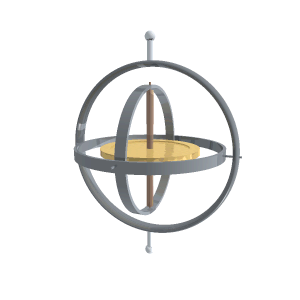Gimbal
Gimbal is a pivoted support that allows the rotation of an object about a single axis. A set of three gimbals, one mounted on the other with orthogonal pivot axes, may be used to allow an object mounted on the innermost gimbal to remain independent of the rotation of its support. For example, on a ship, the ship's compass would be mounted on gimbals to keep it level while the ship pitched and rolled. The term "gimbal" originated from the Latin gimbalus, which itself is derived from the Greek γύμβαλον (gymbalon), meaning "ring" or "circle".
History[edit | edit source]
The gimbal was first described by the inventor Philo of Byzantium (280–220 BC) in his work on pneumatics. Throughout history, gimbals have been used in various devices, especially in maritime navigation to support compasses and the marine chronometer, allowing them to function accurately regardless of the motion of the ship.
Design and Function[edit | edit source]
A gimbal system consists of two or three rings, called gimbals, mounted on axes at right angles to each other. The outer gimbal (or ring) is fixed to a pedestal, while the inner gimbal(s) has/have the object mounted so that it remains in the same orientation regardless of any movement of its support. In a three-axis gimbal, the innermost ring, which holds the object, is able to rotate on three axes: pitch, yaw, and roll.
Applications[edit | edit source]
Gimbals have a wide range of applications in both the consumer and professional sectors. They are extensively used in:
- Photography and Videography: To stabilize cameras, allowing for smooth, cinematic shots even when moving.
- Aerospace: In spacecraft and satellites, gimbals are used to orient thrusters and antennas.
- Maritime Navigation: Historically used to keep compasses and chronometers operational regardless of ship movement.
- Virtual Reality (VR) and Augmented Reality (AR): To track and adjust the orientation of devices.
- Drones: To stabilize cameras and sensors for aerial photography, surveying, and inspections.
Modern Developments[edit | edit source]
With advancements in technology, electronic gimbals have become popular, especially in photography and videography. These devices use motors and gyroscopic sensors to stabilize the camera. Unlike traditional mechanical gimbals, electronic gimbals can actively correct for unwanted movement, resulting in exceptionally smooth video footage even in challenging conditions.
See Also[edit | edit source]
Search WikiMD
Ad.Tired of being Overweight? Try W8MD's physician weight loss program.
Semaglutide (Ozempic / Wegovy and Tirzepatide (Mounjaro / Zepbound) available.
Advertise on WikiMD
|
WikiMD's Wellness Encyclopedia |
| Let Food Be Thy Medicine Medicine Thy Food - Hippocrates |
Translate this page: - East Asian
中文,
日本,
한국어,
South Asian
हिन्दी,
தமிழ்,
తెలుగు,
Urdu,
ಕನ್ನಡ,
Southeast Asian
Indonesian,
Vietnamese,
Thai,
မြန်မာဘာသာ,
বাংলা
European
español,
Deutsch,
français,
Greek,
português do Brasil,
polski,
română,
русский,
Nederlands,
norsk,
svenska,
suomi,
Italian
Middle Eastern & African
عربى,
Turkish,
Persian,
Hebrew,
Afrikaans,
isiZulu,
Kiswahili,
Other
Bulgarian,
Hungarian,
Czech,
Swedish,
മലയാളം,
मराठी,
ਪੰਜਾਬੀ,
ગુજરાતી,
Portuguese,
Ukrainian
Medical Disclaimer: WikiMD is not a substitute for professional medical advice. The information on WikiMD is provided as an information resource only, may be incorrect, outdated or misleading, and is not to be used or relied on for any diagnostic or treatment purposes. Please consult your health care provider before making any healthcare decisions or for guidance about a specific medical condition. WikiMD expressly disclaims responsibility, and shall have no liability, for any damages, loss, injury, or liability whatsoever suffered as a result of your reliance on the information contained in this site. By visiting this site you agree to the foregoing terms and conditions, which may from time to time be changed or supplemented by WikiMD. If you do not agree to the foregoing terms and conditions, you should not enter or use this site. See full disclaimer.
Credits:Most images are courtesy of Wikimedia commons, and templates, categories Wikipedia, licensed under CC BY SA or similar.
Contributors: Prab R. Tumpati, MD





